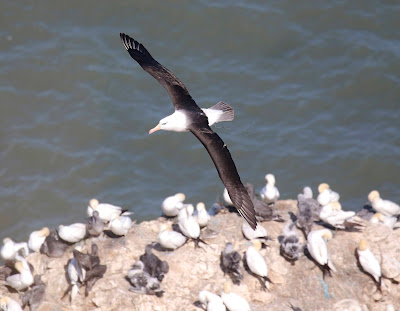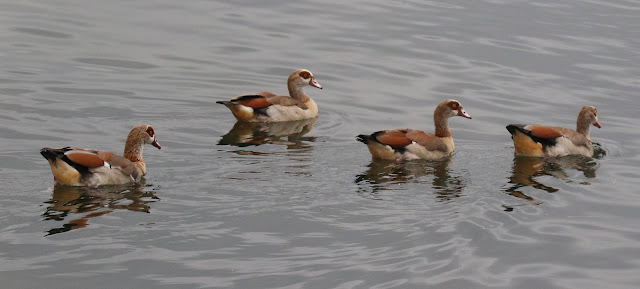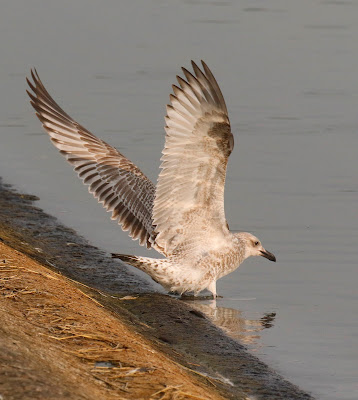Mark, my twitching pal, was itching to go birding this Saturday following a week of suffering an ear infection and a variety of crap events that life throws at you from time to time.
After some discussion it was decided we would go to see a very lost White tailed Plover from the Middle East and Central Asia which was currently striding around the muddy pools at the RSPB's Blacktoft Sands Reserve in East Yorkshire rather than being in its winter home in East Africa or India.
A White tailed Plover is very much a 'mega' in twitcher parlance and only six have been seen in Great Britain.This one at Blacktoft would be the seventh. Both Mark and myself have seen one before. In my case at Rainham RSPB in July 2010 and Mark at Caerlaverock WWT in June 2007.
Later Mark decided to add another 'mega' to our visit to Yorkshire - the much celebrated and long staying Black browed Albatross at another RSPB reserve, Bempton Cliffs also in East Yorkshire.Having become somewhat obessed in getting the ultimate photo of the albatross Mark, accompanied and abetted in no small measure by yours truly, has visited Bempton five times already in his quest and this would be our sixth visit. His plan was for us to get to the albatross at dawn (6am) and once he had got the images he desired we would proceed south to Blacktoft and all being well see the White tailed Plover. A great day's birding by anyone's reckoning if it all went to plan
On Thursday I met Peter, a local Oxfordshire birding colleague who is not really what one would term a hardcore twitcher, and I suggested he might like to come with us as he would have a very good chance of seeing two quality birds which he had never seen before. All he had to do was sit in the back of Mark's car and relax as we drove north. Such an offer was surely not to be missed and Peter duly accepted.
We were all set. At a half hour after midnight on Friday I collected Peter from his home just outside Oxford and we drove across country to Mark's home in Bedfordshire where we transferred to his car and were soon traversing the highways of hell leading north.
One brief stop for a break and a coffee at an eerily deserted McDonalds in the wee hours and soon we were on our way once more.We arrived at Bempton as planned, just after dawn. It was going to be a beautiful day and the sun rose above the horizon, a ball of fiery red as we walked along the cliff edge path to the Staple Newk Viewpoint. This being the best location to observe the albatross if it was about.
 |
| Sunrise at Bempton Cliffs |
We were not the first to occupy the viewpoint and in fact it was almost full but being a Bank Holiday Saturday this was hardly unexpected. We each found a space and a lady who was local to the area informed us the albatross had been seen at just after 6am but was now thought to be perched out of view under the cliff to our left.
For Peter the albatross was a much desired bird so his anxiety levels were higher than ours but for an hour there was no indication the albatross was going to fly around and give us the views we wanted.Two hours had passed and I was beginning to wonder if the albatross really had perched on the cliff or maybe slipped out to sea un-noticed.If the latter was the case we would not see it as on previous occasions it had only returned a day or so later. I began to feel tired and despondent as doubts nagged at my inner self.
Thankfully someone arrived to tell us the albatross was indeed on the cliff and visible from further south on the cliffs and from where it could be seen quite clearly but was invisible to those of us on the viewpoint. Peter, along with others who had never seen the albatross, departed for a view of the bird, eventually returning having seen it reasonably well and thus Peter ticked off another lifer.
Knowing the albatross was on the cliff gave us renewed hope and expectation that it would soon fly around the cliffs but for another four hours there was no indication it was going to. It was not unpleasant listening to the constant rhythmic growling of the Gannets, a noise somewhat similar to that of a starter motor failing to persuade an engine into life and a constant acoustic backdrop to the beautiful location we found ourselves in.
The Gannets whirled around in front of us, riding the updraughts of air, some even landing on ledges of the cliff that fell away from the viewpoint. Below, on a stack many Gannets sat, each guarding their single youngster, now almost full grown and in their juvenile grey plumage starred with a myriad of white spots.
 |
 |
| Gannets |
The sun shone warm as the north wind blew on my face.The sea was shades of blue and green with the polka white dots of resting Gannets bobbing on the swell as far as you could see.The viewpoint became crowded, overfull in fact as the vigil for the albatross to leave its cliffside perch continued. Some gave up and went off in search of something else, the rest of us remained, stoic and determined to see it out one way or the other. Three, four, five hours had passed with nothing to get excited about. We got to know our neighbours and started up conversations to while away the time.Two Harbour Porpoises created a mild stir of distraction as their black torpedo forms showed in the swell far below.
Midday had now arrived and Mark was getting anxious as indeed was I. Tired from my early start last night I slid to the wooden decking floor with my back against the railings.I closed my eyes.It may have been minutes or even seconds when the local lady standing beside me suddenly exclaimed.
'There's the albatross! Its flying!'
Briefly, panic and pandemonium ensued on the viewpoint. The same cry came from everyone. 'Where?'
'Its right in front at twelve o' clock heading out over the stack with all the gannets'.
I scrambled to my feet and desperately tried to locate it. A hasty enquiry to the local lady by my side
'Sorry.Where is it?'
'It's flying away, straight out from us'.
I scanned with my bins and it seemed to take an age to locate it but there was the huge bird surprisingly hard to pick out amongst the gannets, gliding just above the waves and heading inexorably out to sea.
No! Please don't do that. Not after all the waiting, hoping and endless patience we have shown!The albatross continued heading away but then settled on the sea and commenced bathing.Only a few still had it in sight but they kept on it in case it flew again. Someone who came here regularly gave faint hope by telling us it often did this before returning to fly around the cliff.
The albatross was a fair way out, amongst some gannets on the sea but clearly visible in my bins.The best that can be said was it had stopped flying away from us but its current position was far from satisfactory from my point of view.
It was around thirty five minutes past noon when the albatross rose off the sea. Heart in mouth time. It could go either way. Would it fly further out to sea or return to the cliffs? It did neither but began cruising along parallel to the cliff and a long way out. Everyone was praying that it would come closer but for now it was content to cruise along, making wide circles as if it would disappear out to sea at any moment but always it turned and commenced flying towards us and each time it was coming marginally closer.
The albatross slowly came closer, circling wide and then heading directly for us before circling again. A buzz of adrenalin and excitement fizzed through us. It was coming ever closer and surely was going to eventually be really close to the cliff.
It's over the white surf line.
Its under the cliff to our right
Its huge!
Oh my God!Look at its wings!
I never thought I would see one!
It's wonderful!
Look its got a huge pink bill!
I can see its eyes.It's so close!
We're so lucky we came to Bempton today!
They could not stop eulogising, as did many others, but who could be critical of anyone deriving such manifest enjoyment, wonder and awe at seeing this beautiful and celebrated creature? They will never forget this experience and will relate it to their friends and somewhere along the line they or someone they talk to will develop an interest and appreciation of the natural wonders of the world they inhabit.
The albatross can be said, with no exaggeration, to have put on a performance which put our previous encounters in its company truly in the shade. It was just sublime, as time after time, the albatross circled in front of us, passing over the stack, still inundated with Gannets and their almost fully grown young.
The albatross had left its cliffside perch and first appeared at around fifteen minutes past noon and had been on view virtually constantly since. It was now one o'clock The superb encore came when the huge bird came up on the air currents to almost level with us, so very, very close, cruising past us and then circling out in a wide arc before coming back into the cliffs once again.
Finally it disappeared for the last time behind the cliff to our left where it liked to perch. The performance was over and Mark was exultant with one of his images. It was the perfect underwing shot and the image he always wanted.We could feel his excitement and were pleased that at last he had, for now, satisfied a longing he had nurtured all summer.
 |
| Mark's image of the underwings of the albatross |
We decided there was little point in going for the plover in the glare of the early afternoon sunshine.We would wait for the later afternoon but what to do in the meantime?
Lunch was the answer, a proper lunch in a cafe, not a sandwich from the Coop and we headed for Flamborough, finally settling at the very, very busy cafe on Flamborough Head a few miles from Bempton.
It was noisy, hectic and crowded, with everyone making the utmost of the glorious weather. We ordered tea with fish and chips, well we were beside the seaside, and after downing that lot got out of the scrum of people and headed for Blacktoft.It was now around three and with the ninety minute drive to come we would arrive at Blacktoft at just about the right time.
The White tailed Plover had been regularly reported throughout the day on Rare Bird Alert (RBA) so I was reasonably confident we would get to see it. The drive through the pleasant Yorkshire countryside seemed longer than anticipated but finally we entered the unattractive surrounds of Goole which lies on the southside of the River Humber and followed the distinctive brown RSPB signs as they led us around the town and then down winding roads until we came to the reserve's discrete entrance.
The last report of the plover was that it could be seen from the Townend Hide so we made for there. I was concerned that the hide would be full but my worries were needless.There was plenty of room but no plover. The person next to me told me it had just flown off to Xerox Hide at the other end of the reserve and that was where everyone had gone.
I left and made a dash for the Xerox Hide which was more crowded but someone kindly moved up to let me have a seat. Again no plover. It was explained the plover was here but out of sight behind an island of reeds and rank vegetation. We decided to sit for a while and wait it out. Apparently White tailed Plovers prefer to feed in well vegetated wet areas that provide good cover and not out in the open like Lapwings or most other waders.This might be a long wait.
A short while later one of the very friendly RSPB staff came along and enquired
'Is there anyone here who has not seen the plover yet?'
We confirmed we had not and were told that it was viewable from the small visitor centre that lies equidistant between the Xerox and Townend Hides, and we should go there and would be able to see the plover. Due to covid restrictions only visitors who had not seen the plover were allowed in the centre.
After a quick walk back to the centre and instructions on the covid protocols we were told where it was. The view was hardly crippling (another twitching term meaning exceptional) but adequate, the plover's, fawn and white body on very long yellow legs just visible beyond a large reed bed. It was feeding amongst some godwits. I made way for Peter to scope it and he duly recorded his second lifer.
I contented myself that at least I could now say I had seen the plover but really wanted to see it better than this and get a photo if possible, then the day from my point of view would be regarded as a total success. A debate ensued amongst us about which hide it would be best to choose to get a chance of seeing the plover and in the end we split up with Peter going to the Xerox Hide, while Mark and myself opted for the Townend Hide.If the plover showed at either we could alert each other via our mobile phones.
There were of course other birds to see and from the Townend Hide we got good views of feeding Black tailed Godwits and Green Sandpipers. Ruff and Common Snipe fed more distantly, Mark found a Water Rail, as usual skulking in and out of the reeds and Bearded Tit calls pinged from the reeds. Sadly the White tailed Plover which had been seen well from here earlier in the day failed to fly in.
 |
| Black tailed Godwit |
 |
| Green Sandpiper |
The late afternoon was moving slowly into early evening, the harsh light now become golden and soft. Peter sent a text saying he could not see the plover from the Xerox Hide. Twenty minutes later he sent another text saying the plover had come out from behind the reed island and could be seen.
We left for the Xerox Hide but by the time we got there the plover had gone back behind the reeds.So frustrating. Another long wait ensued, hoping that the plover would come out from behind the reeds but time passed by and the only slim hope was if something flushed the waders that were feeding out of sight behind the reeds. Two passes over the reedbeds beyond by individual Marsh Harriers raised our hopes but they were not close enough to trouble the hidden waders.
Time was running out and I had resigned myself to the fact it was not going to happen when there was a sudden flight of waders from behind the reeds. Black tailed Godwits and Green Sandpipers suddenly appeared in front of us in a flurry of mild alarm but initially we could see no sign of the plover.
Someone said it had not flown out but then someone else said
'Hang on.What's that?'
'There it is.Right in front of us. It's almost the closest wader to us!'
Indeed it was.Oh wow!
Through my bins I admired its incredibly long, thin yellow legs, (think of knitting needles bent in the middle) which supported its body, the colour of milky coffee above and whitish below apart from a pale brown breast patch.
Its head was also pale brown and featureless apart from prominent dark eyes in its plain face. It kept much to itself and its typical plover feeding action of short steps and then pausing to scrutinise the watery mud was distinctive.
We watched and photographed it for twenty minutes but then it ran to our left and became invisible once more behind some reeds, its dislike of being out in the open all too apparent.
We left the hide, buoyed by this last minute triumph.The drive home would be long and boring and having been up for at least twenty six hours I would suffer the consequences for the next day or two but for now I really could not care.
We had succeeded in what we had set out to achieve and that was all that mattered.

























































